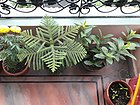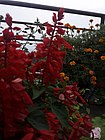Note: This is a project under development. The articles on this wiki are just being initiated and broadly incomplete. You can Help creating new pages.
Difference between revisions of "Tagetes - Marigold"
(→External Links) |
|||
| (11 intermediate revisions by 2 users not shown) | |||
| Line 1: | Line 1: | ||
| − | [[File: | + | [[File:Tagetes erecta 03.JPG|thumb|right|''Marigold'', ''Tagetes'']] |
| − | |||
'''Tagetes''' is a genus of about 15–20 species of annual and perennial herbaceous plants in the daisy family Asteraceae that are often known as marigolds. They are native to southwestern Asia, western Europe, Macaronesia, and the Mediterranean. | '''Tagetes''' is a genus of about 15–20 species of annual and perennial herbaceous plants in the daisy family Asteraceae that are often known as marigolds. They are native to southwestern Asia, western Europe, Macaronesia, and the Mediterranean. | ||
==Uses== | ==Uses== | ||
| − | {{Uses| | + | {{Uses|Minor cuts}}, {{Uses|Cuts}}, {{Uses|Burns}}, {{Uses|Liver disorders}}, {{Uses|Skin irritation}}, {{Uses|Eczema}}, {{Uses|Sore eyes}}, {{Uses|Poor appetite}}, {{Uses|Gas problem}}, {{Uses|Intestinal worms}}. |
==Parts Used== | ==Parts Used== | ||
| − | {{Parts Used|Flower petals}}, {{Parts Used| | + | {{Parts Used|Flower petals}}, {{Parts Used|Dried flowers}}, {{Parts Used|Leaves}}. |
==Chemical Composition== | ==Chemical Composition== | ||
| Line 13: | Line 12: | ||
==Common names== | ==Common names== | ||
| − | {{Common names|kn=|ml=|sa=|ta=|te=|hi=|en= | + | {{Common names|kn=|ml=|sa=|ta=|te=|hi=Genda|en=Marigold, African Marigold}} |
==Properties== | ==Properties== | ||
| Line 32: | Line 31: | ||
==Habit== | ==Habit== | ||
| − | {{Habit| | + | {{Habit|Small plant}} |
==Identification== | ==Identification== | ||
===Leaf=== | ===Leaf=== | ||
| − | {{Leaf|Simple| | + | {{Leaf|Simple|Alternate|Lobed or unlobed but not separated into leaflets}}<ref name="Leaf"/> |
===Flower=== | ===Flower=== | ||
| − | {{Flower|Unisexual|2-4cm long| | + | {{Flower|Unisexual|2-4cm long|Pink to red|5|The flower head has tubular disk flowers in the center and ray flowers, these often strap-shaped, around the periphery}} |
===Fruit=== | ===Fruit=== | ||
| − | {{Fruit|General|7–10 mm| | + | {{Fruit|General|7–10 mm|Clearly grooved lengthwise, Lowest hooked hairs aligned towards crown|-|-}} |
===Other features=== | ===Other features=== | ||
==List of Ayurvedic medicine in which the herb is used== | ==List of Ayurvedic medicine in which the herb is used== | ||
| − | |||
==Where to get the saplings== | ==Where to get the saplings== | ||
| Line 57: | Line 55: | ||
==Commonly seen growing in areas== | ==Commonly seen growing in areas== | ||
| − | {{Commonly seen| | + | {{Commonly seen|Pine-oak forest zone}}, {{Commonly seen|Along road sides}}. |
==Photo Gallery== | ==Photo Gallery== | ||
| Line 83: | Line 81: | ||
<references> | <references> | ||
| − | <ref name="chemical composition">[http://bioinfo.bisr.res.in/project/domap/plant_details.php?plantid=0127&bname=Tagetes%20erecta | + | <ref name="chemical composition">[http://bioinfo.bisr.res.in/project/domap/plant_details.php?plantid=0127&bname=Tagetes%20erecta Chemical constituents]</ref> |
| − | <ref name="Leaf">[https://gobotany.newenglandwild.org/species/tagetes/patula/ | + | <ref name="Leaf">[https://gobotany.newenglandwild.org/species/tagetes/patula/ Plant Characteristics]</ref> |
| − | <ref name="How to plant/cultivate">[https://www.mdidea.com/products/herbextract/marigold/data01.html | + | <ref name="How to plant/cultivate">[https://www.mdidea.com/products/herbextract/marigold/data01.html Cultivation deatils]</ref> |
</references> | </references> | ||
| Line 93: | Line 91: | ||
* [https://www.britannica.com/plant/marigold Tagetes on britannica.com] | * [https://www.britannica.com/plant/marigold Tagetes on britannica.com] | ||
* [https://plants.ces.ncsu.edu/plants/all/tagetes-erecta/ Tagetes on plants.ces.ncsu.education] | * [https://plants.ces.ncsu.edu/plants/all/tagetes-erecta/ Tagetes on plants.ces.ncsu.education] | ||
| − | * [https://www.almanac.com/plant/marigolds Tagetes on | + | * [https://www.almanac.com/plant/marigolds Tagetes on almanac.com] |
* [https://www.gardeningknowhow.com/ornamental/flowers/marigold/marigolds-with-yellow-leaves.htm Marigold Leaf Problems: Treating Marigolds With Yellow Leaves] | * [https://www.gardeningknowhow.com/ornamental/flowers/marigold/marigolds-with-yellow-leaves.htm Marigold Leaf Problems: Treating Marigolds With Yellow Leaves] | ||
[[Category:Herbs]] | [[Category:Herbs]] | ||
Latest revision as of 16:31, 18 August 2020
Tagetes is a genus of about 15–20 species of annual and perennial herbaceous plants in the daisy family Asteraceae that are often known as marigolds. They are native to southwestern Asia, western Europe, Macaronesia, and the Mediterranean.
Contents
- 1 Uses
- 2 Parts Used
- 3 Chemical Composition
- 4 Common names
- 5 Properties
- 6 Habit
- 7 Identification
- 8 List of Ayurvedic medicine in which the herb is used
- 9 Where to get the saplings
- 10 Mode of Propagation
- 11 How to plant/cultivate
- 12 Commonly seen growing in areas
- 13 Photo Gallery
- 14 References
- 15 External Links
Uses
Minor cuts, Cuts, Burns, Liver disorders, Skin irritation, Eczema, Sore eyes, Poor appetite, Gas problem, Intestinal worms.
Parts Used
Flower petals, Dried flowers, Leaves.
Chemical Composition
Thiophenes, natural phytochemicals that include sulfur-containing rings, lutein.[1]
Common names
| Language | Common name |
|---|---|
| Kannada | |
| Hindi | Genda |
| Malayalam | |
| Tamil | |
| Telugu | |
| Marathi | NA |
| Gujarathi | NA |
| Punjabi | NA |
| Kashmiri | NA |
| Sanskrit | |
| English | Marigold, African Marigold |
Properties
Reference: Dravya - Substance, Rasa - Taste, Guna - Qualities, Veerya - Potency, Vipaka - Post-digesion effect, Karma - Pharmacological activity, Prabhava - Therepeutics.
Dravya
Rasa
Tikta (Bitter), Kashaya (Astringent)
Guna
Laghu (Light), Ruksha (Dry), Tikshna (Sharp)
Veerya
Ushna (Hot)
Vipaka
Katu (Pungent)
Karma
Kapha, Vata
Prabhava
Habit
Identification
Leaf
| Kind | Shape | Feature |
|---|---|---|
| Simple | Alternate | Lobed or unlobed but not separated into leaflets |
Flower
| Type | Size | Color and composition | Stamen | More information |
|---|---|---|---|---|
| Unisexual | 2-4cm long | Pink to red | 5 | The flower head has tubular disk flowers in the center and ray flowers, these often strap-shaped, around the periphery |
Fruit
| Type | Size | Mass | Appearance | Seeds | More information |
|---|---|---|---|---|---|
| General | 7–10 mm | Clearly grooved lengthwise, Lowest hooked hairs aligned towards crown | - | - | {{{6}}} |
Other features
List of Ayurvedic medicine in which the herb is used
Where to get the saplings
Mode of Propagation
How to plant/cultivate
Sow seeds in situ in spring, cover lightly with soil. The only precaution is to keep the birds away long enough for the seeds to germinate and grow. For maximum freshness, please keep seed refrigerated in its original packaging until it is time to plant. [3]
Commonly seen growing in areas
Pine-oak forest zone, Along road sides.
Photo Gallery
References
External Links
- Ayurvedic Herbs known to be helpful to treat Minor cuts
- Ayurvedic Herbs known to be helpful to treat Cuts
- Ayurvedic Herbs known to be helpful to treat Burns
- Ayurvedic Herbs known to be helpful to treat Liver disorders
- Ayurvedic Herbs known to be helpful to treat Skin irritation
- Ayurvedic Herbs known to be helpful to treat Eczema
- Ayurvedic Herbs known to be helpful to treat Sore eyes
- Ayurvedic Herbs known to be helpful to treat Poor appetite
- Ayurvedic Herbs known to be helpful to treat Gas problem
- Ayurvedic Herbs known to be helpful to treat Intestinal worms
- Herbs with Flower petals used in medicine
- Herbs with Dried flowers used in medicine
- Herbs with Leaves used in medicine
- Herbs with common name in Hindi
- Herbs with common name in English
- Habit - Small plant
- Index of Plants which can be propagated by Seeds
- Index of Plants which can be propagated by Cuttings
- Herbs that are commonly seen in the region of Pine-oak forest zone
- Herbs that are commonly seen in the region of Along road sides
- Herbs






